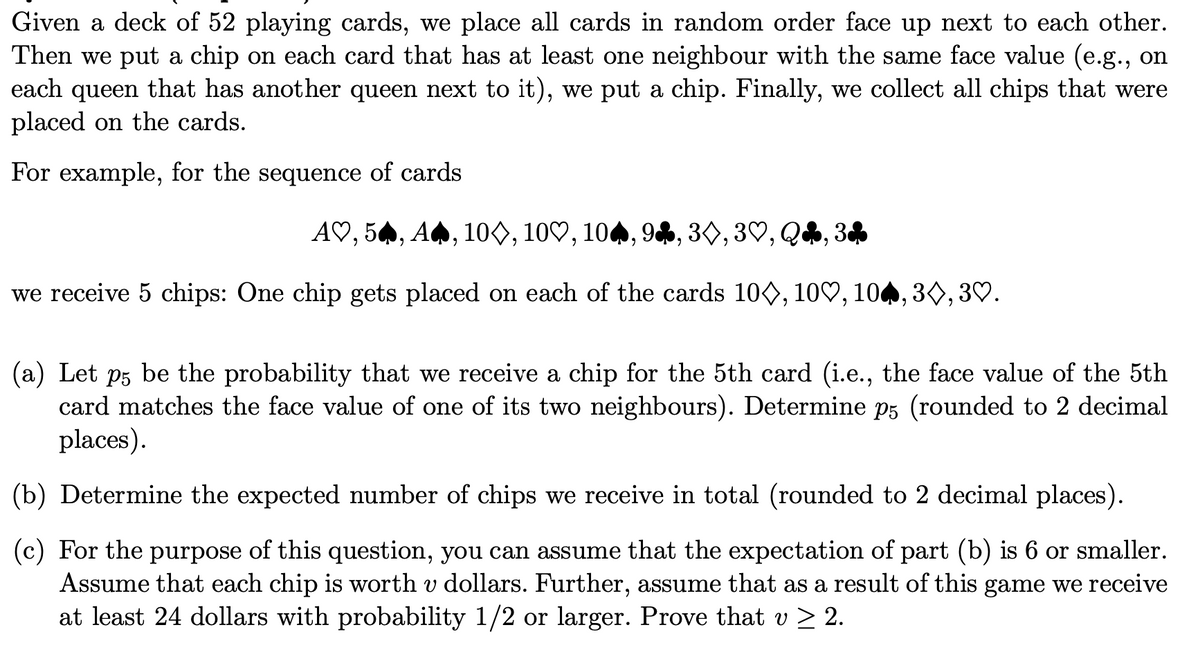Given a deck of 52 playing cards, we place all cards in random order face up next to each other. Then we put a chip on each card that has at least one neighbour with the same face value (e.g., on that has another queen next to it), we put a chip. Finally, we collect all chips that were each queen placed on the cards. For example, for the sequence of cards AV, 54 , 100, 10♡, 104, 9, 30, 3♡, Q4, 3 we receive 5 chips: One chip gets placed on each of the cards 100, 10♡, 104, 30, 3♡. (a) Let p5 be the probability that we receive a chip for the 5th card (i.e., the face value of the 5th card matches the face value of one of its two neighbours). Determine p5 (rounded to 2 decimal places). (b) Determine the expected number of chips we receive in total (rounded to 2 decimal places). (c) For the purpose of this question, you can assume that the expectation of part (b) is 6 or smaller. Assume that each chip is worth v dollars. Further, assume that as a result of this game we receive at least 24 dollars with probability 1/2 or larger. Prove that v > 2.
Given a deck of 52 playing cards, we place all cards in random order face up next to each other. Then we put a chip on each card that has at least one neighbour with the same face value (e.g., on that has another queen next to it), we put a chip. Finally, we collect all chips that were each queen placed on the cards. For example, for the sequence of cards AV, 54 , 100, 10♡, 104, 9, 30, 3♡, Q4, 3 we receive 5 chips: One chip gets placed on each of the cards 100, 10♡, 104, 30, 3♡. (a) Let p5 be the probability that we receive a chip for the 5th card (i.e., the face value of the 5th card matches the face value of one of its two neighbours). Determine p5 (rounded to 2 decimal places). (b) Determine the expected number of chips we receive in total (rounded to 2 decimal places). (c) For the purpose of this question, you can assume that the expectation of part (b) is 6 or smaller. Assume that each chip is worth v dollars. Further, assume that as a result of this game we receive at least 24 dollars with probability 1/2 or larger. Prove that v > 2.
Database System Concepts
7th Edition
ISBN:9780078022159
Author:Abraham Silberschatz Professor, Henry F. Korth, S. Sudarshan
Publisher:Abraham Silberschatz Professor, Henry F. Korth, S. Sudarshan
Chapter1: Introduction
Section: Chapter Questions
Problem 1PE
Related questions
Question
100%

Transcribed Image Text:Given a deck of 52 playing cards, we place all cards in random order face up next to each other.
Then we put a chip on each card that has at least one neighbour with the same face value (e.g., on
that has another queen next to it), we put a chip. Finally, we collect all chips that were
each
queen
placed on the cards.
For example, for the sequence of cards
A♡, 54, A4, 10O, 10♡, 104, 94, 30, 3♡, Q4, 34
we receive 5 chips: One chip gets placed on each of the cards 100, 10♡, 104, 30, 3♡.
(a) Let p5 be the probability that we receive a chip for the 5th card (i.e., the face value of the 5th
card matches the face value of one of its two neighbours). Determine p5 (rounded to 2 decimal
places).
(b) Determine the expected number of chips we receive in total (rounded to 2 decimal places).
(c) For the purpose of this question, you can assume that the expectation of part (b) is 6 or smaller.
Assume that each chip is worth v dollars. Further, assume that as a result of this game we receive
at least 24 dollars with probability 1/2 or larger. Prove that v > 2.
Expert Solution
This question has been solved!
Explore an expertly crafted, step-by-step solution for a thorough understanding of key concepts.
Step by step
Solved in 2 steps with 3 images

Recommended textbooks for you

Database System Concepts
Computer Science
ISBN:
9780078022159
Author:
Abraham Silberschatz Professor, Henry F. Korth, S. Sudarshan
Publisher:
McGraw-Hill Education

Starting Out with Python (4th Edition)
Computer Science
ISBN:
9780134444321
Author:
Tony Gaddis
Publisher:
PEARSON

Digital Fundamentals (11th Edition)
Computer Science
ISBN:
9780132737968
Author:
Thomas L. Floyd
Publisher:
PEARSON

Database System Concepts
Computer Science
ISBN:
9780078022159
Author:
Abraham Silberschatz Professor, Henry F. Korth, S. Sudarshan
Publisher:
McGraw-Hill Education

Starting Out with Python (4th Edition)
Computer Science
ISBN:
9780134444321
Author:
Tony Gaddis
Publisher:
PEARSON

Digital Fundamentals (11th Edition)
Computer Science
ISBN:
9780132737968
Author:
Thomas L. Floyd
Publisher:
PEARSON

C How to Program (8th Edition)
Computer Science
ISBN:
9780133976892
Author:
Paul J. Deitel, Harvey Deitel
Publisher:
PEARSON

Database Systems: Design, Implementation, & Manag…
Computer Science
ISBN:
9781337627900
Author:
Carlos Coronel, Steven Morris
Publisher:
Cengage Learning

Programmable Logic Controllers
Computer Science
ISBN:
9780073373843
Author:
Frank D. Petruzella
Publisher:
McGraw-Hill Education